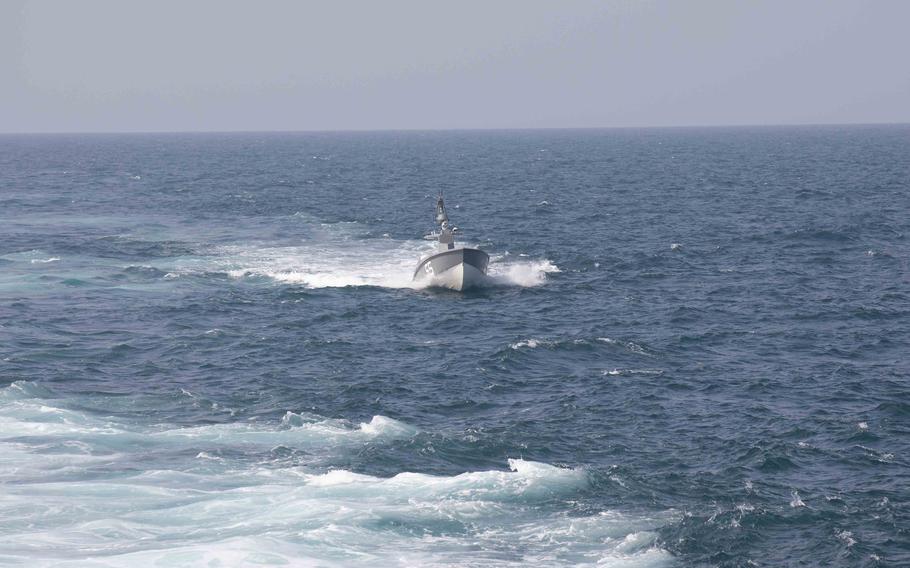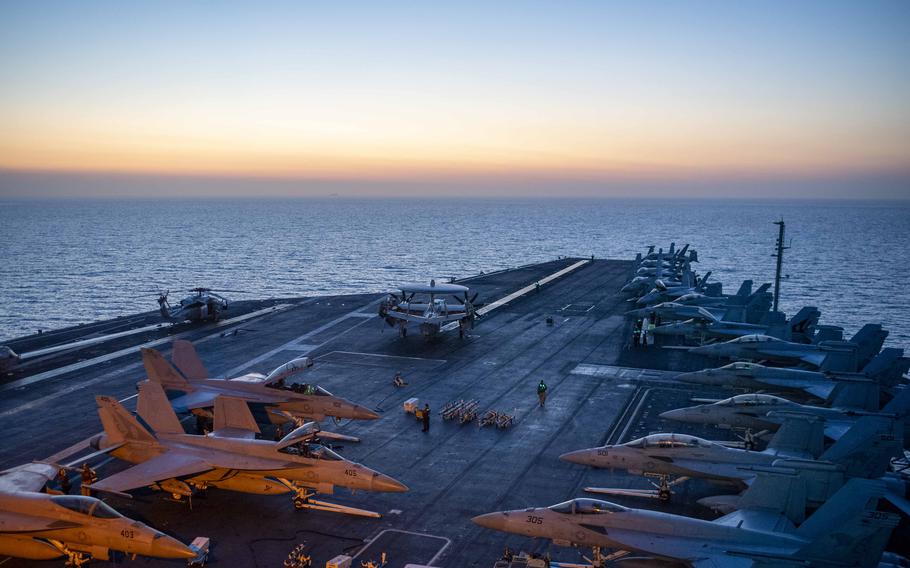
An Arabian Fox MAST-13 unmanned surface vessel, attached to U.S. Naval Forces Central Command’s Task Force 59, conducts surveillance in the Arabian Gulf on Nov. 21, 2023. (Tyrin Saunders/U.S. Army)
WASHINGTON — Houthi rebels in Yemen, who have been threatening U.S. forces and commercial ships in the Middle East for weeks, are now using one-way, unmanned attack boats to target vital shipping lanes in the region, a top Navy commander said Thursday.
The Iranian-backed Houthis have been engaged in civil war in Yemen for a decade and have dramatically increased their attacks in the region since the Israel-Hamas conflict began in early October.
“There are no signs their irresponsible behavior is abating,” said Vice Adm. Brad Cooper, who commands U.S. Navy operations in the Middle East. “Since Nov. 18, there have now been 25 attacks against merchant vessels transiting the southern Red Sea and Gulf of Aden.”
To safeguard key commercial shipping routes for international trade in the Red Sea and Gulf of Aden, the Pentagon last month began Operation Prosperity Guardian, a multinational security pact to increase patrols and bolster defenses in the area. So far, it is composed of about two dozen countries.
The waterways are within range of militant attacks from nations such as Yemen, Egypt and Somalia. In recent weeks, the Houthis have targeted dozens of commercial vessels with rockets and attack drones.
On Thursday, U.S. forces spotted a new threat from the Houthis — an unmanned surface vessel, or USV. Cooper said the vessels was packed with explosives and detonated about 50 miles off the coast of Yemen. It exploded just a few miles away from U.S. warships and commercial vessels. No ships were damaged, and there were no injuries. Cooper, who is the commander of the 5th Fleet, described the unmanned vessels as low-profile drone boats and said they are “a concern.”
Since Operation Prosperity Guardian was created in mid-December, more than 1,500 commercial ships have safely navigated the shipping lanes with the increased security presence of U.S. and coalition forces, Cooper said. He also said the operation is gaining more international support because the Houthi attacks are affecting dozens of countries.
“Fifty-five nations have direct connections to the ships that have been attacked,” he said. “The impacts of these attacks stretch across the globe. As we have said, this is an international problem that requires an international solution.”

The aircraft carrier USS Dwight D. Eisenhower in the Red Sea on Nov. 5, 2023. The carrier is deployed to the U.S. 5th Fleet area of operations to help ensure maritime security and stability in the Middle East region. (Nicholas Rodriguez/U.S. Navy)
Cooper said the increased Houthi attacks pose a danger beyond just the shipping lanes. Because the unsophisticated Houthi weapons often miss their intended targets, he said others in the Red Sea and Gulf of Aden are also vulnerable. Since the beginning of Operation Prosperity Guardian on Dec. 18, U.S. and coalition forces have shot down 19 attack drones and missiles and sunk at least three small boats, Cooper said.
“We have the largest surface and air presence in the southern Red Sea in years,” he said of the operation, which is “entirely defensive in nature.”
“It is very difficult to discern whether a missile is coming right at you or the merchant vessel adjacent to you,” Cooper said. “So, we have taken the appropriate approach of protecting ourselves and downing these missiles using prudent self-defense. Easy call.”
U.S. warships in the region have shot down many missiles and drones fired by Houthi rebels in Yemen in the last two months. For example, the USS Carney downed more than a dozen Houthi-fired attack drones over the Red Sea on Dec. 16 alone. Earlier this week, Cooper visited the Arleigh Burke-class destroyer as it was stationed in Bahrain to present commendations to the sailors for their actions. On Dec. 26, U.S. forces shot down several Houthi missiles and drones in a firefight that lasted 10 hours. Other Iranian-backed militant groups have also carried out more than 100 attacks on U.S. bases in Iraq and Syria since the start of the Israel-Hamas conflict, but none have caused serious injuries to U.S. personnel or major property damage.
Since the Oct. 7 Hamas attack on Israel, the United States has moved more armed forces to the Middle East with three main priorities: add stability to the region, deter other countries and militant groups from escalating the conflict, and protect American personnel stationed in the area.
“These attacks threaten innocent lives from all over the world and constitute a significant international problem that demands collective action,” the U.S. and 12 other countries said in a joint statement Wednesday that warned the Houthis to stop the attacks. “The Houthis will bear the responsibility of the consequences should they continue to threaten lives, the global economy, and free flow of commerce in the region’s critical waterways.”